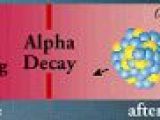Nuclear reactions are the basic processes that power stars and which are responsible for the production of all elements. In case of radioactive elements these nuclear reactions are behind the spontaneous decay of one atom and the creation of another type of atom. During such an event various particles are emitted from the atom's nucleus.
There are three types of radioactive decay:
- Decays with the emission of a nucleons - Beta decays with the emission of electrons (or positrons) and neutrinos - Gamma emission
Among the most well known decays of the first type is the alpha decay, which consists in the emission of a helium nucleus. Other similar decays include emissions of neutrons or protons.
Working with an international team of scientists (from Germany, Belgium, Russia, Bulgaria, Poland, Italy and Spain), Sam Tabor, a Florida State University physics professor has created a silver atom with odd radioactive properties never observed before.
They have conducted an experiment at the GSI laboratory in Darmstadt, Germany, in which a thin film of nickel foil was bombarded with a beam of calcium atoms, causing some nickel and calcium ions to coalesce to form silver atoms with fewer neutrons than normal. The deficit of neutrons in the silver had deformed the nuclei from spheres into fat cigar shapes.
While most of these silver atoms decayed conventionally, some didn't. The new type of radioactive decay consists in ejecting two free protons simultaneously. In some cases the proton pairs jumped out from the same end of the cigar-shaped nucleus, at other times from opposite ends, but they were always perfectly synchronized, Tabor said. "It's like there's a captain on board telling them exactly when to dive," he said.
The scientists expected that the engineered atoms (containing fewer neutrons than in the atom's natural state) would break down by emitting protons one at a time. The correlated two-proton decay hadn't been seen before.
"The purpose of this line of research is to expand our knowledge of nuclear physics beyond those nuclei present in nature by exploring nuclei with either fewer or more neutrons," Tabor said. "This will help us to understand even the stable nuclei. Another motivation is the fact that such unstable nuclei play important roles in astrophysics and the production of the elements on Earth. We cannot fully understand the astrophysical processes by which even the atoms in our body were produced until we understand the structure of neutron-rich and neutron-poor nuclei."
The researchers also plan to explore what happens in case of atoms with neutron excesses. This future study will be conducted at the Superconducting Accelerator Laboratory at Florida State University.

 14 DAY TRIAL //
14 DAY TRIAL // 


